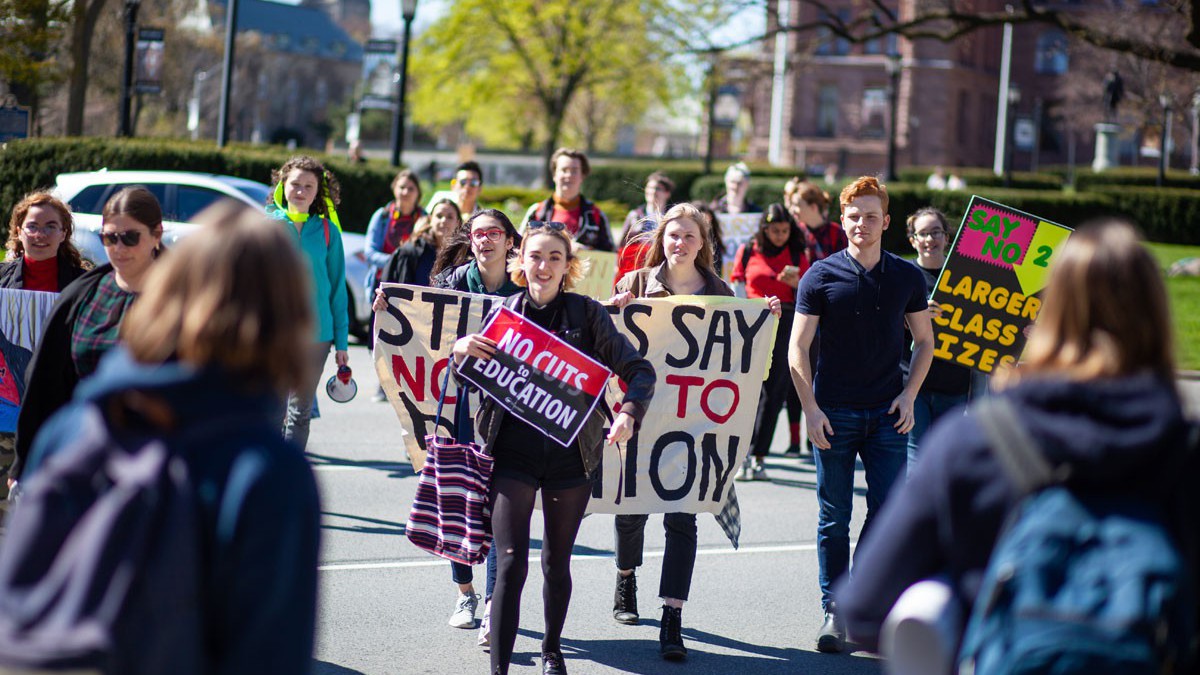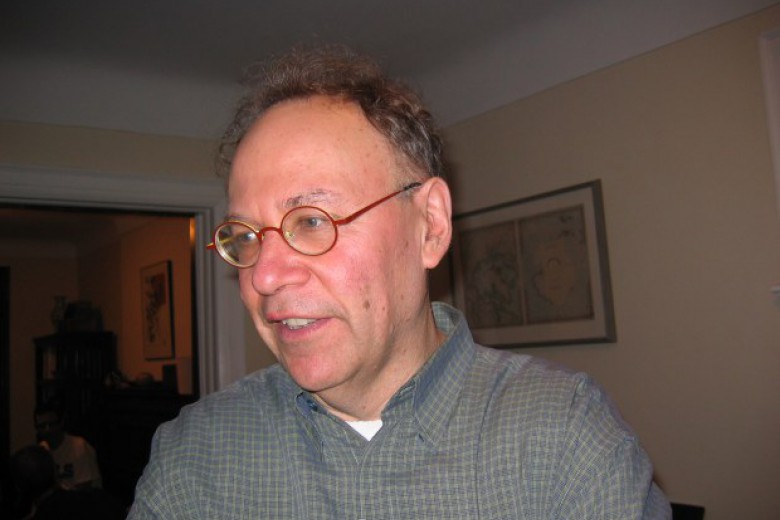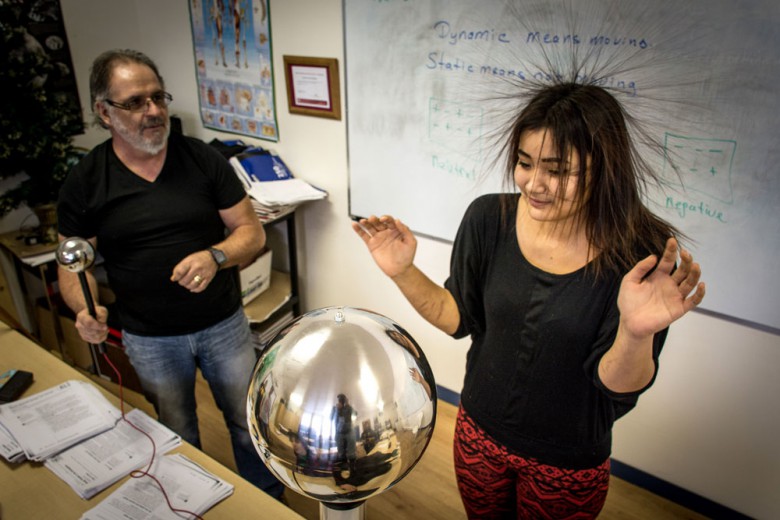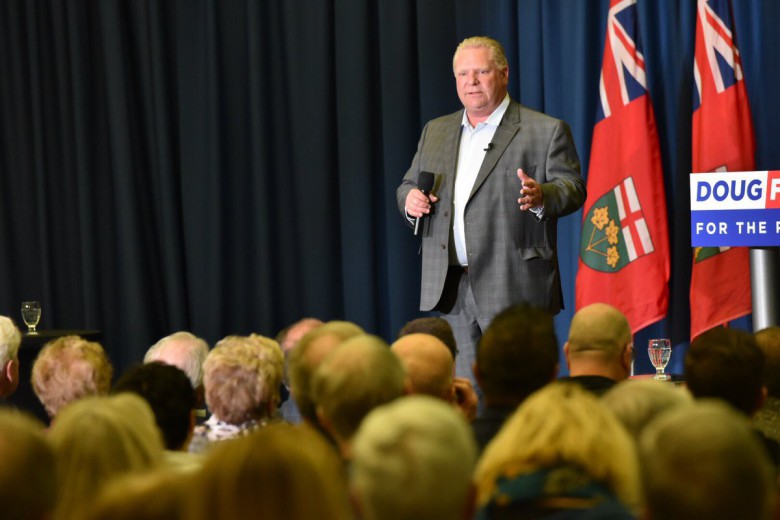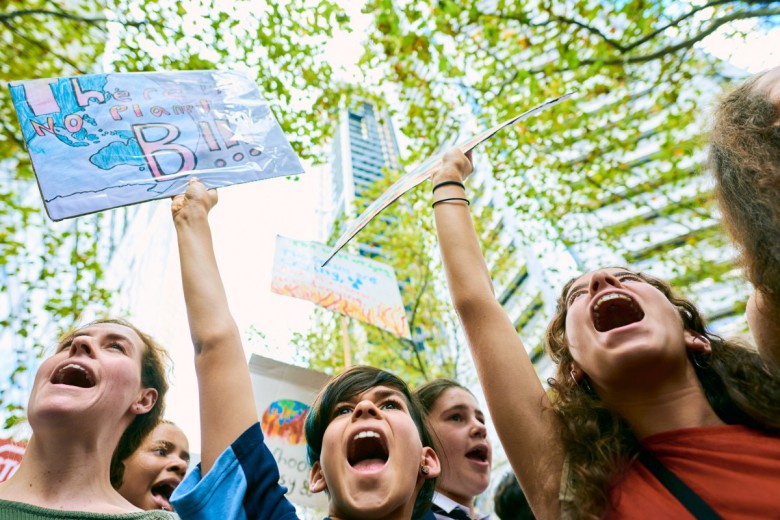“We’ve heard that people like to make memes about Doug Ford. Could you describe one of them?” asks a journalist from a mainstream media outlet.
“I’m sorry, I can’t,” replies Amina Vance, an 18-year-old organizer of the Students Say No (SSN) group fighting Ford’s cuts to public education. “Let me tell you another story.”
Memes are low-hanging fruit for reporters hoping to play up the youth and social-media savvy of high-school organizers – but a bustling social movement they do not make. Amina is right: there is a better story here.
Since coming to power, Ontario’s premier, Doug Ford, has relentlessly attacked public education: proposing a 20 per cent education funding cut; introducing targeted erosion of arts courses; increasing class sizes and cutting at least 5,844 teachers’ jobs; slashing the Ontario Autism Program, Indigenous curricula, and post-secondary financial assistance; introducing mandatory e-learning and a classroom cellphone ban; and slashing $100 million from a school repair fund.
But students of all ages have been relentless, too. On April 4, nearly 200,000 high-school and middle-school students across Ontario walked out of their classes in protest of Ford’s devastating cuts to education. More than 700 schools participated in the largest student walkout in Canadian history. Reporters and older activists alike are asking: how did high schoolers pull it off?

Students Say No is a coalition of students from across the province that formed to demand a reversal of Ford’s cuts. As SSN’s walkouts unfolded, I watched Ford and the mainstream media repeat the same shallow and tired narratives about youth movements – that they’re “political ploys” orchestrated by teachers or unions, and that their success can be chalked up to social media finesse. But when I dug a little deeper, I was excited by the new – and old – organizing tactics that the SSN activists were using. I wondered: what could older activists learn from this new generation of radicals? And given the potential for an Ontario teachers’ strike after the expiration of their collective agreements on August 31, what could solidarity between teachers and students look like?
The ladder to mass high-school mobilization
Before becoming a core organizer with SSN, Savi Gellatly-Ladd – who is 16 years old – was organizing with Not Just Rumours, a student group protesting sexual misconduct in schools. Amina had just graduated high school in June and was organizing with groups like the Ontario Coalition Against Poverty. Both of them come from families of organizers, and Amina and Savi finally met one another at a Fight for $15 and Fairness action in November of 2018.
When I sat down with them, both articulated a political analysis of capitalism that was far more incisive than what I had at their age. Education is “one of the last […] strongholds against a real age of austerity,” Amina tells me. Savi adds that education is “useful for fighting against oppression,” particularly given that the high-school content on the chopping block is that which directly challenges systems of oppression, like curriculum revisions called for by the Truth and Reconciliation Commission.
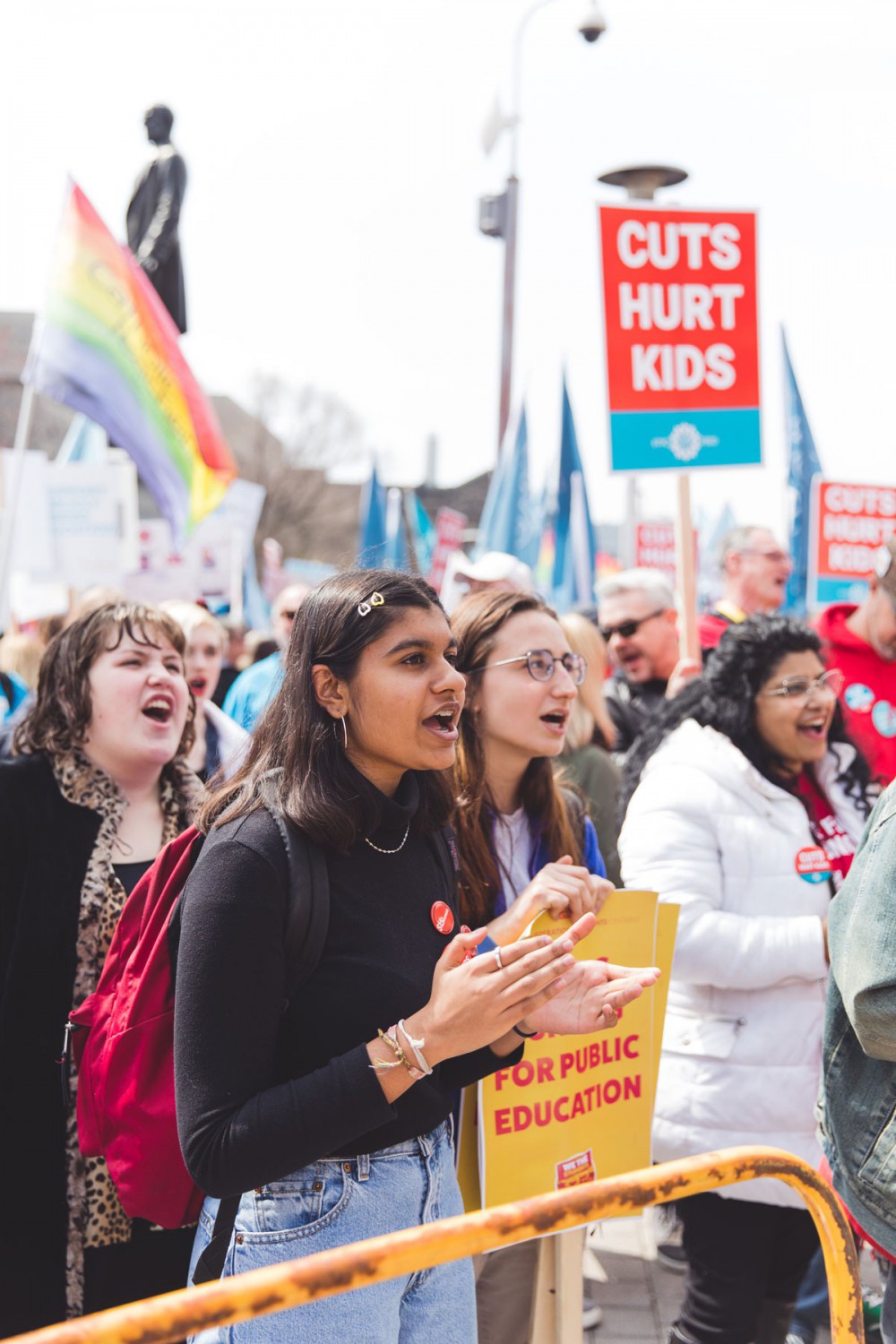
Ford’s cuts to education are “a specific attack on people’s ability to think,” continues Amina. “A deeply broken system can only self-sustain when people are uneducated about how messed up it is.” That’s why Amina and Savi have been trying to help their peers, and the public, understand how Ford’s cuts fit into a broader program of austerity and hard-right social conservativism.
Ford’s plan – announced in July 2018 – to impose an outdated sex-ed curriculum that lacked discussion of consent, gender identity, and queer relationships was a wake-up call for many. Young people organizing through the March for Our Education – another high-school group protesting Ford’s education cuts – coordinated a campaign called “We the students do not consent.” In September of 2018, 40,000 students from nearly 100 schools across the province walked out of their classes.
For students, taking direct action against the cuts was “a brand new idea for them; the fact that you could have something happen to you and then respond is crazy,” says Amina.
A few months later, students won major concessions around the sex-ed curriculum, wherein consent, sexually diverse relationships, and gender identity would remain in the curriculum, though shifted to later grades. A new generation of young people is becoming radicalized, and that fall they got a taste of what winning feels like.
The sex-ed walkout primed students, as well as administrators, for subsequent mobilizations. In early 2019, Ford announced sweeping cuts to all levels of the public education system, from elementary schools to post-secondary institutions. Using clear messaging, Students Say No was successful in drawing out 200,000 students from more than 700 registered schools – likely an underestimate, given that SSN wasn’t able to process all 3,000 registration requests at the time – to challenge these cuts. Just two days later, 30,000 education workers and allies also rallied at Queen’s Park.
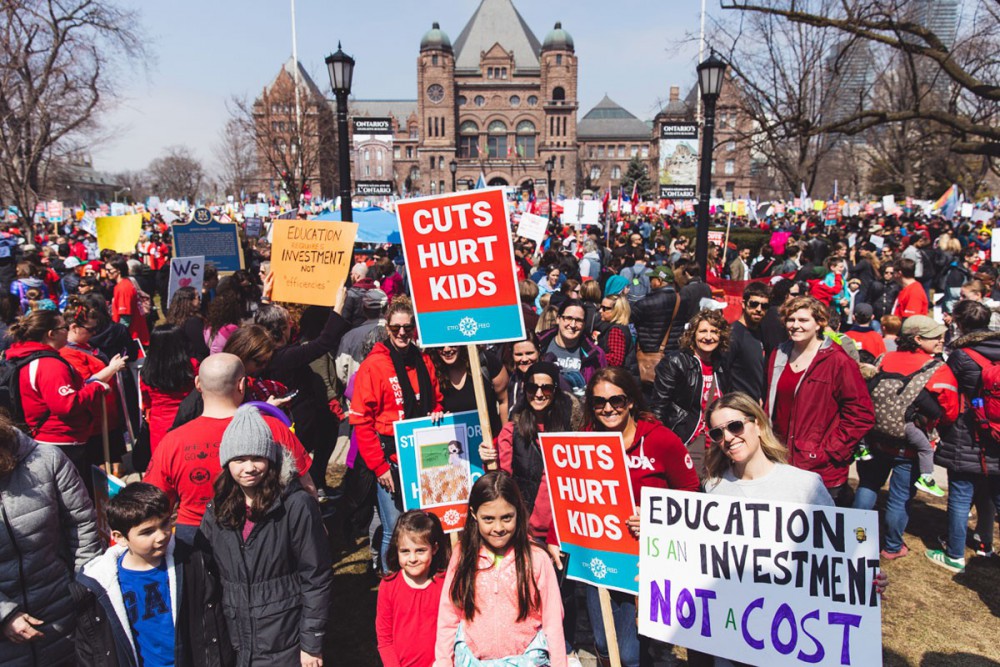
Amina and Savi say SSN’s success can be attributed to: (1) decentralized actions that let local schools and nascent organizers take the lead using SSN toolkits; (2) highly accessible actions, particularly for students organizing under the radar in Conservative ridings; and (3) prioritizing the safety of students.
Although students had walked out in the fall, some still harboured fears of arrest, suspension, and other punishment. Savi reassured her classmates: “This is safe. You’re allowed to do this. This is how a lot of things happen – like, you gotta fight back. You are able to fight back.”
Amina was “quite proud” that SSN pushed to secure legal support from the Canadian Civil Liberties Association so that they can assure students that their right to political expression is constitutionally protected. Through every available platform – the organizer guide, Instagram, email – Amina was clear that “we will back you up.”
“I spent many, many, many hours, hundreds of hours, DM’ing people: ‘You won’t get arrested, I promise,’” she tells me. Particularly for students from marginalized and over-policed neighbourhoods, this security was a prerequisite to participation.
In addition to unambiguous language around safety, SSN had “a huge amount of information going out all the time,” Amina notes. She found that immediately sending out “really simple, clear information about what the impact of the cuts was,” meant that students would be more receptive if they heard about “at least one thing” that directly affected them. But instead of focusing only on making the cuts relevant to students, SSN also sought to increase their political savvy: explaining what members of provincial parliament (MPP) are and how to take up space at their constituency offices.
“So many students just learned […] what a union is,” emphasizes Amina. “When Ford says ‘union thugs,’ most students do not know what [a] union is, and are like ‘Oh, I’ll look that up now.’”
While SSN calls for coordinated actions, they encourage schools to autonomously organize. Some schools in Brampton and Windsor-Essex have continued throwing rallies, especially for school-specific issues. Using SSN’s resources, students now have the confidence to say: “Yeah! I can throw a rally. I’m allowed to, and I’m gonna,” says Amina.
Gaming the algorithm
The reporter’s question about memes wasn’t entirely off the mark. Young organizers are intentional about using the social media tools that they’re most comfortable with to drum up massive support.
But the platform differs based on who they’re trying to reach. For the media and parents, organizers posted press releases and announced events on Facebook. They worked with student organizers in different cities on the chat application Discord. They used email to communicate with students and allies not plugged into social media. But ultimately, it was Instagram where the bulk of their public-facing organizing took place.
In 2018, 64 per cent of Instagram’s users were between the ages of 18 and 34, and it’s experienced a meteoric rise in popularity since Facebook bought the app in 2012. On the surface, Instagram looks like one of the least likely ways to build a mass movement. The image-based platform discourages text, making political discussions and the posting of press releases unwieldy. Unlike Facebook, it has no function to create events, and it doesn’t allow clickable links in posts or comments. Users are allowed to put just one clickable link in their profile page’s description (called a bio).
Instagram claims that it doesn’t allow clickable links in order to maintain a clean user interface, though some argue it traps users within the app and makes it less amenable to political (as well as commercial) content. To circumvent Instagram’s link chokehold, SSN simply linked to a website called Linktree – a site that, on a single page, presents a number of clickable links to everything from shared Google docs to PayPal accounts – in their Instagram bio, to distribute their organizing guide and registration process. The organizers’ guide provides information on legal supports; creating a school-specific Instagram account; building a local team of organizers; outreach tactics; and logistics for actions, like renting sound equipment and inviting speakers.
“We know it games the algorithm. […] It’s just like a tool that you have to use because it’s a way [for] connecting to people. And the real organizing does happen in person. Always.”
Amina tells me that each post from the SSN provincial Instagram account averages 10,000 impressions (the total number of times people have seen the post) and 2,000 likes.
SSN organizers stick to one simple rule when posting on Instagram: “The algorithm prefers anything that has longer engagement,” says Amina, and that keeps a user’s eyes glued to the screen for longer. So Amina and Savi intentionally post videos (for example, footage from an action) instead of photos, preferring talking heads over infographics.
Posts that encourage users to interact and comment on them, using creative captions (“Name the number one thing you’d change about our education”), are further boosted. Amina doesn’t mind the trolls, either – she says they end up helping more than hurting by directing more users to the posts.
SSN also uses Instagram stories – posts that stay up for just 24 hours – which Amina says are “good depending on how many stories in a row you’re posting and what time of day you post. So, peak times: 6 p.m., 9 p.m., 3 p.m.”
Instagram livestreams further allow organizers to answer pressing questions and quell anxieties – a tactic popularized by young politicians, most famously Alexandria Ocasio-Cortez. To Amina, the rationale is clear: “people like seeing you – we’re human. […] People just trust you more.”
Referring to the aforementioned set of online tactics, Amina says, “We know it games the algorithm. […] It’s just like a tool that you have to use because it’s a way [for] connecting to people. And the real organizing does happen in person. Always.”
Out with the old, in with the new? Forging novel solidarities
Every good organizer also appreciates the importance of solidarity in movement building. For high-school organizers, a natural alliance exists with parents and with teachers, for whom a province-wide strike looms. This was put into action on June 6, when parents, teachers, and students from 300 registered schools across the Greater Toronto Area rallied and “walked in” together before school started – a tactic first used in 2013 by teachers in North Carolina protesting education cuts. Spearheaded by the students, Amina points to this day as “a powerful show of solidarity between all three levels.”
Walk-ins have a tactical advantage: they allow for teachers, who are not allowed to walk out of school, to join students and parents in morning protests before walking in to school to resume their duties. At her school, Savi found that parents “were eager to support us” and “have a strong sense of community, which was very useful in terms of outreach.”
Teachers, however, are trickier to engage. In the recent past, school districts have tried to punish teachers who publicly expressed opposition to government policies that increased class sizes and degraded other classroom conditions. Plus, teachers take their lead from their unions, which must navigate their own limiting bureaucracy and are restricted by labour laws that narrow the scope and possibility of strike action. So “as students, we often have more agency and less restrictions” than teachers, says Amina. And students are keen to transcend symbolic actions, like wearing buttons and the “Red for Ed” T-shirts on Fridays.
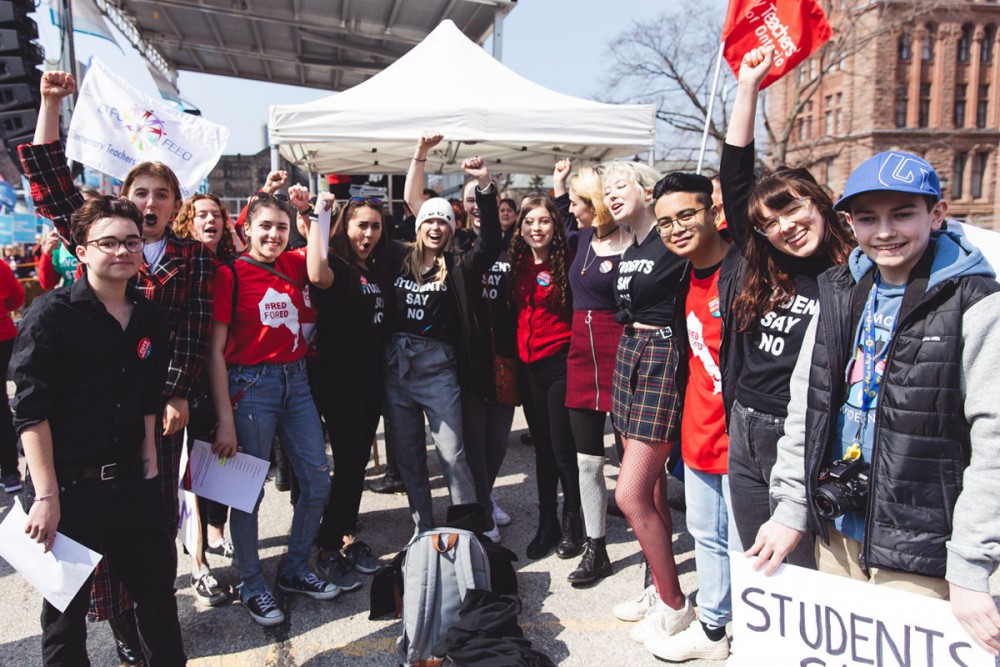
Both Savi and Amina would like to see stronger solidarity between teachers and students. Amina aspires for “province-wide walk-ins – all teachers’ unions, all parents, all students. That’s my hope. And if it’s not walk-ins, some other coordinated actions. But I want teachers and parents to show up for students, and to show up for each other.” Savi adds, “it would be so powerful if students and teachers could go on a strike” together.
Successful teacher-student solidarity work isn’t without precedent: a wave of inspiring (and illegal) teachers’ strikes in West Virginia, Arizona, and Oklahoma in 2018 resulted in historic wins because unions centred demands that resonated with students and communities, such as smaller class sizes and stopping U.S. Immigration and Customs Enforcement (ICE) raids.
Amina astutely points out that “this government benefits so much when they are able to treat us like we’re divided, like teachers aren’t parents, and like students and parents don’t care.”
Recognizing that Amina just graduated high school and Savi is one year away from graduation, another question is: how do high-school organizers continue their work during the summers and after graduation?
Many youth are, unsurprisingly, gravitating toward climate organizing with groups such as the Fridays for Future climate strikers, Climate Justice Toronto, Our Time, and Extinction Rebellion. “We know that erosion of social services, [under] neoliberalism and austerity, is part of the broader fight that we need to save our futures,” says Amina.
The forces behind the climate crisis and cuts to education are one and the same: the capitalist imperative for profit at the expense of workers, communities, and the planet.
Climate activists would further argue that education workers have “low-carbon” jobs – those that meaningfully sustain our communities and do the least damage to the planet while being at the front lines of austerity. Intentionally linking the struggles for public education and climate justice would mean that our anti-capitalist movements are stronger and more holistic in their demands.
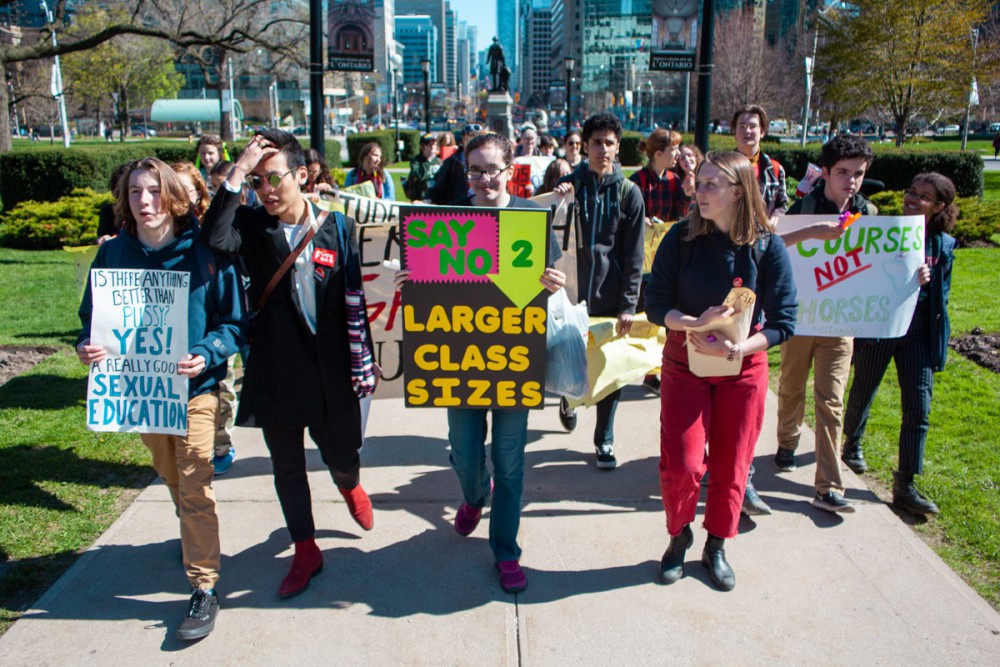
There are many ways to begin to do this solidarity work. Teachers’ unions like the Elementary Teachers’ Federation of Ontario – which has been particularly active in the fight against Ford – ought to materially support young people’s calls for a Global Climate Strike from September 20-27. Unions should pass climate resolutions for a Green New Deal, just as the Canadian Federation of Nurses Unions did, and recognize that young people striking for the climate are also current and future workers themselves. And in the event that teachers decide to strike, teachers’ unions should open up concrete avenues for students and families to support their demands like smaller class sizes and more paid sick days. The possibilities are endless, but they require intentionality.
A stronger anti-austerity movement also requires listening – without condescension – to the lessons learned from high schoolers’ work with SSN. First, high-energy, welcoming, impactful actions draw people out and keep them showing up. “When people see a good, strong, effective action, they recognize it. […] Don’t mess people around,” advises Amina – especially through what she calls “meaningless” noon actions at Queen’s Park.
Second, don’t just invite the same people already organizing, especially in cross-movement work: invite everyone, everywhere, and build their capacity to organize locally. Amina’s personal goal is “finding organic leaders and providing [them] with the tools to [organize] in their own communities.” The road to a successful movement is paved with building people’s local, self-sustaining power.
Finally, treat people like they’re smart – especially young people – because they are. Frustration over young people’s perceived apathy is understandable but misdirected, according to Amina: “Most people, it’s not that they don’t want to come out, it’s just that their entire life, they’ve been told that they’re not allowed to.”
“Talk to the young people in your life,” she adds. “People are smart, students are smart, young people are smart. People will show up if they are given good opportunities to make change.”


